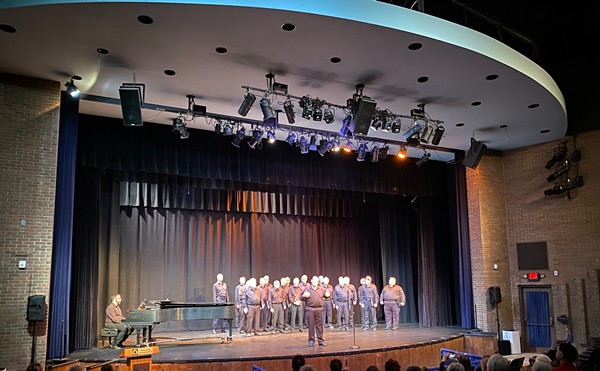If there's a common theme beyond geography in local books, it's probably the ethics of regular people - hard-working, dignified, making beauty from the hands we're dealt, and always hopeful. Three new books from Kent State University Press find those values in three different places: church, art and football.
Revelations
Michael Stephen Levy
Kent State University Press, 2008
150 pages, hardcover, $39
Michael Stephen Levy's Revelations: Photographs of Cleveland's African American Churches, with its forward by Stephanie Tubbs Jones, came out just before the passing of the late congresswoman. Her short essay is a fitting start to a book full of joy and beauty against all odds.
These are reverent photos, shot without flash so as not to disturb the services they capture. Photographer Levy notes that to tell the story of the pictures, he juxtaposed photos, running them together to create a single image. Sometimes the mix is about content, and sometimes it's about lines and other elements of composition. The drama of the architecture and range of emotion makes both options compelling. The compositional elements in some of the pictures are so strong - as in an overhead shot of a woman in a wide-brimmed red hat wearing a frilly lavender dress - that they flirt with abstraction.
Others have a documentary wit, like the photo of a storefront converted to the New Revelation Baptist Church, over which resides a billboard featuring a bikini-clad white girl hawking Corona beer. Next to that is a portrait of another storefront church, this one with a plywood door padlocked and flanked by two satellite dishes, like symmetrical acolytes flanking a simple, central steeple.
There are houses converted to churches, storefronts converted to churches, tents used as churches and even services set in Quicken Loans Arena. All these makeshift houses of worship contrast against the grandeur of century-old ecclesiastical architecture, with domes, steeples, choir lofts and sweeping curves of wooden pews.
In one pair of photos, there's the old-world art of stained glass - intricate patterns rich in symmetry and detail at the Pentacostal Church of Christ. Next to it is another kind of stained glass, a storefront window scrawled in spray paint ("R.I.P. Jay") with Cory United Methodist Church in its reflection.
Published by Kent State University Press in cooperation with the CSU Maxine Goodman Levin College of Urban Affairs Center for Sacred Landmarks, it's no mere book of architecture, but a volume that succeeds in capturing the hope and struggle of the people who use it. A couple of other prominent Clevelanders - the Rev. Marvin McMickle and the Rev. Otis Moss - also contributed short bits of writing. Their names and thoughts are matched by the gravity of the photos, with their broad grasp of the emotions that play out in a church, the role of church in the community and the hope that lives inside their walls, no matter what goes on outside of them.
Clyde Singer's
America
M.J. Albacete
Kent State University Press, 2008
186 pages, hardcover,$55
Clyde Singer also portrayed life in the city - scenes bursting with an obvious love for people - but with a distinctly secular, civic point of view. A new book, Clyde Singer's America, edited by Canton Museum of Art Executive Director M.J. Albacete, comes out just in time for the museum's exhibit of the same name, which is open through January 7, 2009.
Born in Malvern, Ohio, in 1908, Singer was a painter even during his childhood, and he never lost that focus, though what it meant to him was less about commercial success and fame than about the simple act of painting. Albacete's biographical essay traces his life, from childhood in the industrial town to classes at the Columbus Arts School (now Columbus College of Art and Design) to a scholarship that took him to New York.
Returning to Ohio, he made his living as a painter, despite the Great Depression. He took a full-time job as artist-in-residence at the Butler Institute in 1940, where he eventually became associate director and worked for the rest of his life. When he died in 1999, he had painted almost 4,000 works.
The book begins with graphite and charcoal portraiture from classes, before switching to scenes of Malvern and other towns. Most of Singer's pictures are crowded with details, especially people: in bars, on the street, gathering for celebrations or at work. All of Singer's people look well-fed and warm, though he doesn't shy from painting grittier details, like a woman sleeping in a bus station with trash below her or a weird club scene where men and women drink while another woman, nude except for her little bit of a grass skirt, gyrates on the floor. His civic orientation shows in scenes of politicians hectoring crowds at Communist and Democratic rallies, a soldier dying on the battlefield or peace protesters in the early '70s. Singer's attention to details and tone makes his works almost immediately identifiable with their period, even though his use of light and perspective, and his realistic sense of proportion, were established early in his career and barely evolved in nearly nine decades.
It's that style that makes him one of Ohio's great artists, and this book a must-have for anyone interested in the region's artistic heritage.
Classic Browns
Jonathan Knight
Kent State University Press, 2008
224 pages, paperback, $16.95
Writing about books connected by their geography requires jarring shifts, and so it is that we come to the peculiar art that is appreciating the Cleveland Browns.
In his Classic Browns: The Fifty Greatest Games in Cleveland Browns History, author Jonathan Knight sifts out the moments that keep the Dawg Pound faithful. He counts down his choices for the best games - not chronologically, but ranked according to their greatness. Each includes a narration of events along with the author's insights about what made the game special, plus a quarter-by-quarter synopsis of scoring drives. Naturally, this is a book in which Cleveland almost always wins. But to count only the winning games would be to disregard games where the Browns never gave up - like the infamous 38-33 loss to the Denver Broncos in 1988, which inspired the great local radio personality Pete Franklin to write that Browns running back Earnest Byner "symbolizes that fighting spirit. He is the guy who refuses to give up, who keeps on battling the opponent." There were plenty of victories - like the 1986 win over the Pittsburgh Steelers that became the Death of the Jinx - but you'll have to buy the book to read about and remember those.











